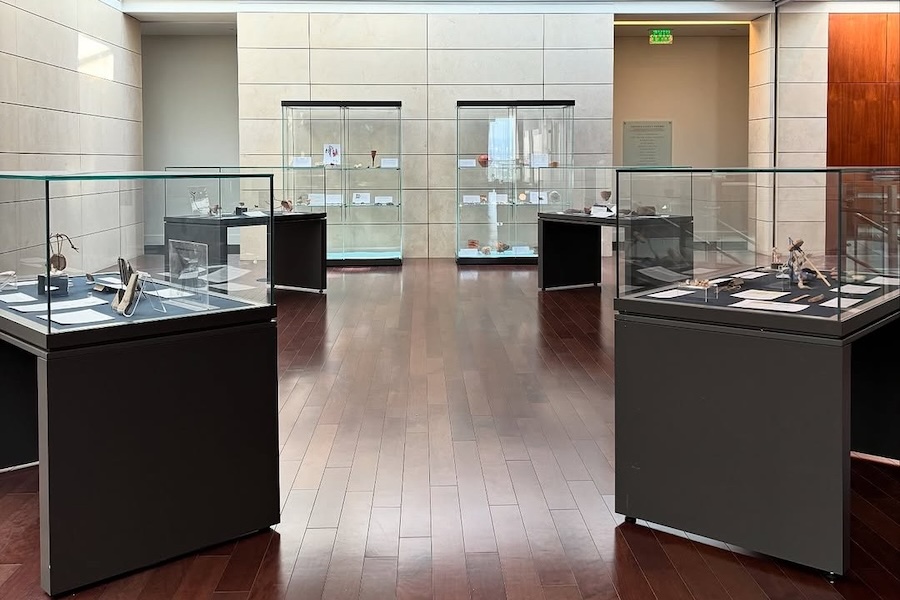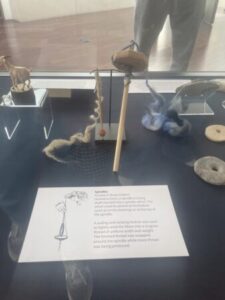Digging Into the Past: LMU Student Brings Ancient History to Life On Campus and in the Field

Margaret Chaney, a Classics and Archaeology major at Loyola Marymount University (Class of 2026), has spent the 2024–25 academic year deeply involved in hands-on archaeological work, both in the classroom and in the field. One of her biggest contributions was helping design and curate A Glimpse Into Ghassul, an exhibition developed in partnership with Professor Caroline Sauvage and a team of fellow students.
The exhibit centers around artifacts from Tuleilat el-Ghassul, a historic site near the Dead Sea in modern-day Jordan. These objects date to the Chalcolithic Period (roughly 4500–3500 BCE), a time of major cultural and technological shifts. This was the era when copper tools started to replace stone ones, religious spaces became part of daily settlements, and the first known wall paintings with spiritual themes appeared. People also began using livestock not just for meat but for milk, wool, and other byproducts—marking what’s known as the “secondary products revolution.” Specialized pottery also emerged, showcasing advancements in ceramic production.

Chaney was one of 11 students in Professor Sauvage’s Fall 2024 course, The Chalcolithic Cultures of the Levant, which explored the region’s pre-Bronze Age history using real artifacts from LMU’s Archaeology Center. Through the class, students spent months preparing the exhibit, researching each item, writing display texts, building layouts, and creating a full visitor experience.
“This exhibit was a nine-month journey,” Chaney shared. “We wrote papers, made drafts, designed mockups—so seeing it all come together and watching people engage with it was incredible. After working so closely with the artifacts, they almost feel like old friends.”
The objects featured in the exhibit were originally excavated between 1929 and 1934 by Père Alexis Mallon, a French Jesuit priest and archaeologist associated with the Pontifical Biblical Institute. At first, Mallon believed he had found the biblical city of Gomorrah, but instead, he uncovered evidence of a completely distinct and vibrant ancient culture. Today, those objects are part of LMU’s collection, and Professor Sauvage—working with Rev. Prof. Josef Mario Briffa, SJ—is leading an international project to formally publish the finds. The project is supported by a White-Levy grant, which helps make these materials accessible to scholars around the world and creates opportunities for Jordanian researchers to study and publish their heritage.
LMU students are contributing to the effort by cataloging and documenting the artifacts using up-to-date standards. Plans for future internships at the Pontifical Biblical Institute in Jerusalem—focused on digitizing original excavation records—are also in the works, depending on regional political developments over the next few years.
“This grant opened doors for a truly global project,” Sauvage explained. “It allows us to publish the material stored in Los Angeles and the excavation notes in Jerusalem. We’re also training young Jordanian scholars—like our ceramic specialist, Shahd Habahbeh, who has just begun analyzing the collection and will receive specialized training in ceramic analysis at the University of Missouri. I also hope to bring in another Jordanian scholar to study the stone tools from the same site.”
The exhibit itself features a variety of themes drawn from daily life in the Chalcolithic era, including home life, textile production, the use of livestock for food and materials, trade and social status, pottery manufacturing, and religious or burial rituals. One item that especially fascinated visitors was the cornet—a goblet-like drinking vessel with no base. Sauvage and Chaney suggested that these may have been used in ritual processions, where participants had to finish their drink before putting the vessel down. Some cornets even had traces of beeswax, hinting they might have doubled as torches.
To honor the history of the artifacts and their original excavator, wine was served at the exhibit’s opening in base-less glasses—mirroring the cornet style—and sourced from a Jesuit vineyard in Lebanon.
“Curating this kind of exhibit gives students real experience,” Sauvage said. “They studied the period in depth, then designed the entire exhibit from the ground up—concepts, research, writing for different audiences, layout planning, setup. They also added interactive elements like photo prompts and puzzles to keep the public engaged.”
Although Chaney was originally set to join an excavation in Jordan this summer, those plans were canceled due to rising tensions between Israel and Iran. Instead, she’ll now take part in a dig in Romania at a site that was once under Roman control during the empire’s final expansion into Dacia. This project will explore how identity, culture, and societal roles were shaped where Roman and local Dacian traditions met.
Previous surveys at the Romanian site uncovered signs of a luxurious rural villa, complete with painted walls, possible colonnades, outbuildings, and two-story structures—all pointing to a rich and layered archaeological record.
Chaney’s upcoming participation is made possible by the American School of Prehistoric Research Award, a competitive scholarship from the Archaeological Institute of America. The award covers travel and other essential costs. “It means a lot to be recognized by an organization like the AIA,” she said. “It’s a big encouragement after all the effort I’ve put into my studies.”
Her journey in archaeology has been shaped by LMU’s close-knit Classics and Archaeology Department. Inspired by Professor Sauvage’s fieldwork in the Near East and her own capstone research on Tuleilat Ghassul, Chaney is now looking forward to deepening her expertise in Roman and Dacian history. In Romania, she’ll get hands-on training in artifact analysis, geophysical survey tools, and fieldwork methods. She’ll spend weekdays at the excavation site and use weekends to explore the surrounding landscape, historic Transylvanian churches, and ancient castles.
With her eyes set on a career in field archaeology, this experience marks the beginning of what promises to be a long and meaningful path uncovering the stories buried in the ground.